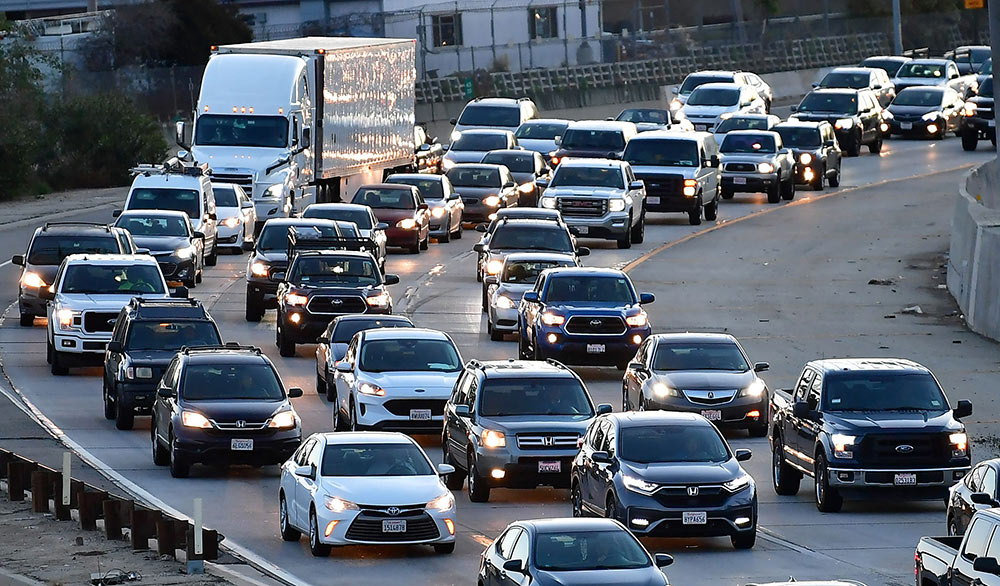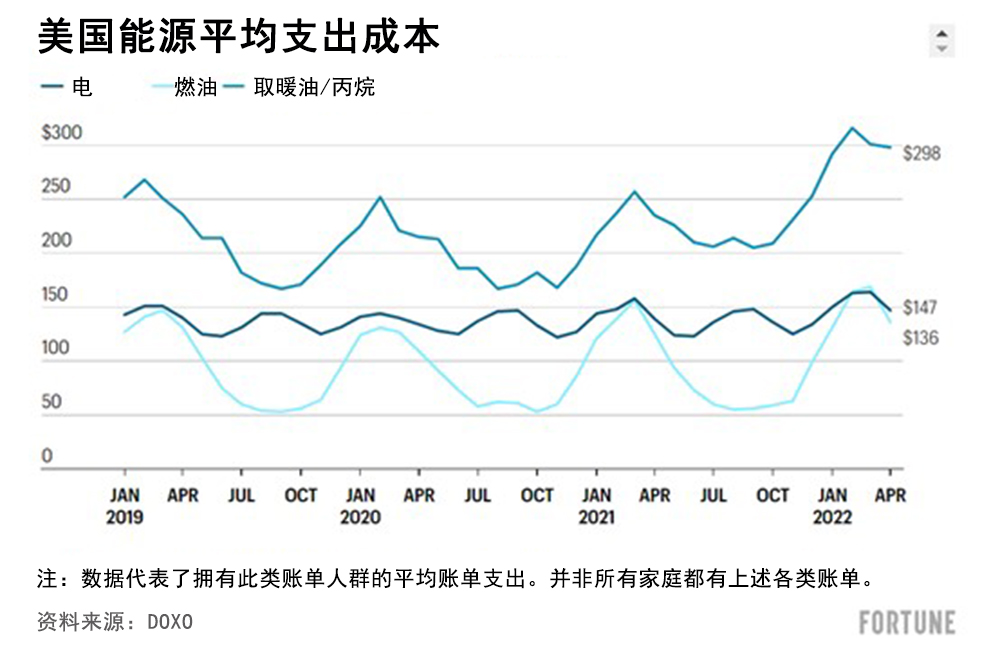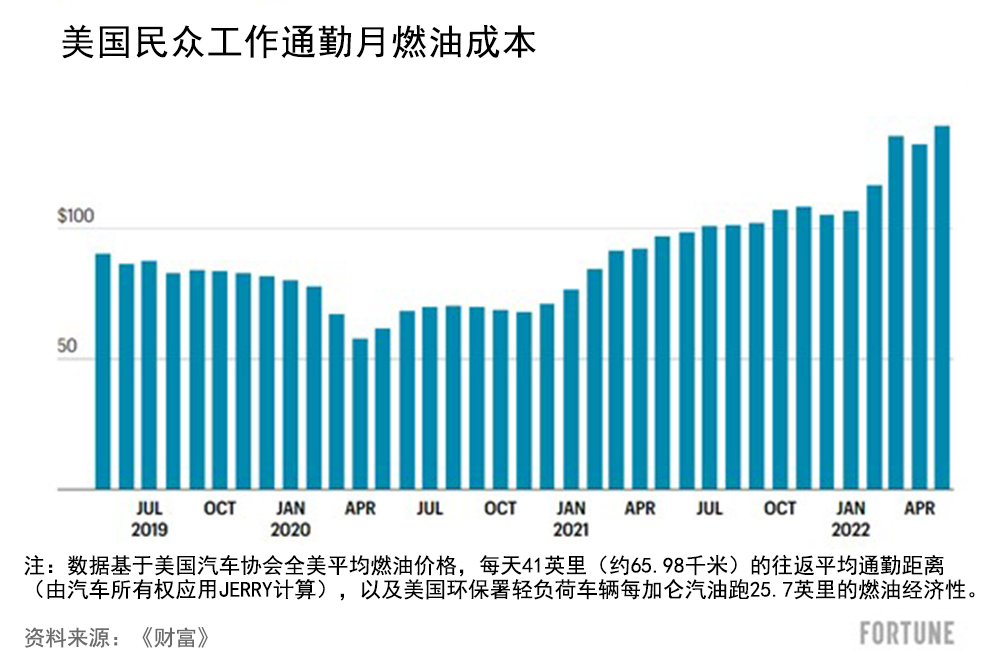
午餐成本增加,、燃油價(jià)格飆升,還有新工作服采購(gòu),,難怪眾多美國(guó)員工紛紛拒絕返回辦公室工作,。
Kastle的“復(fù)工晴雨表”(Back to Work Barometer)報(bào)告在考察了美國(guó)10個(gè)主要城市的辦公室使用率后發(fā)現(xiàn),盡管眾多公司已經(jīng)設(shè)定了4月返回辦公室工作的截止日期,,然而在過(guò)去一個(gè)月中,,美國(guó)辦公室使用率依然穩(wěn)定在43%左右的水平。很多雇員反對(duì)回歸辦公室的原因并非是不斷增長(zhǎng)的新冠病例,,而是通勤成本過(guò)高。事實(shí)上,,德勤(Deloitte)最近的報(bào)告顯示,,近40%的千禧一代和三分之一的Z世代稱,遠(yuǎn)程辦公有助于省錢,。
然而,,居家辦公對(duì)于大多數(shù)員工來(lái)說(shuō)真的是一個(gè)革命性的省錢方式嗎?
盡管居家辦公可以免去通勤之苦,,但這種方式并非是免費(fèi)的,,尤其是考慮到能源成本的不斷上升。美國(guó)勞工統(tǒng)計(jì)局(Bureau of Labor Statistics)的消費(fèi)者價(jià)格指數(shù)顯示,,4月,,僅電費(fèi)的同比增幅就達(dá)到了11%。
如果你每天在辦公室待8小時(shí)或以上的時(shí)間,,而且還吹著公司的空調(diào),,那么這點(diǎn)增幅可能并不是什么大問(wèn)題。然而,,如果是居家辦公,,那么這部分成本將由自己承擔(dān),而且與房屋大小,、空調(diào)系統(tǒng)以及窗戶采光效率等住宅維護(hù)變量等諸多因素息息相關(guān),。何況還有電腦、手機(jī)充電的能耗,,甚至每天還得使用一兩次打印機(jī),。
美國(guó)賬單支付服務(wù)公司Doxo向《財(cái)富》雜志提供的數(shù)據(jù)顯示,,在2022年前4個(gè)月,美國(guó)民眾的月均電費(fèi)和油費(fèi)較2019年同期增長(zhǎng)了23美元,。美國(guó)民眾今年的月均電費(fèi)和天然氣費(fèi)用分別達(dá)到了約156美元和150美元,。使用取暖油和丙烷的費(fèi)用更高,其2022年月均費(fèi)用達(dá)到了302美元,。

即便這些成本在一年中最熱的那幾個(gè)月有所增加,,但對(duì)于大多數(shù)美國(guó)民眾而言也不是什么大問(wèn)題。美國(guó)能源信息管理局( U.S. Energy Information Administration)稱,,2020年夏季,,當(dāng)眾多美國(guó)民眾因封鎖令而遠(yuǎn)程辦公時(shí),居民用電量較2019年夏季增長(zhǎng)了7.9%,,創(chuàng)下了2010年以來(lái)夏季用電量增幅的新高,。
管理局預(yù)測(cè),今年夏天,,也就是2022年6月-8月,,居民用戶月均用電量將達(dá)到約1050度,較2021年夏季降低約2.9%,,部分原因在于更加溫和的溫度預(yù)測(cè),,以及美國(guó)居家辦公民眾數(shù)量的減少。
居家辦公成本可能還得考慮互聯(lián)網(wǎng)成本,。Doxo的數(shù)據(jù)顯示,,美國(guó)民眾2022年年初至今每月在其互聯(lián)網(wǎng)和有線電視上面的平均花費(fèi)約為120美元,與疫情前的水平相當(dāng),。這一點(diǎn)可能會(huì)發(fā)生變化,,因?yàn)橐恍﹩T工傾向于在疫情期間升級(jí)其網(wǎng)絡(luò)帶寬,繼而持續(xù)推高這一方面的月支出,。
通勤成本也在增加
盡管美國(guó)民眾在電費(fèi)方面的開支有所增加,,但不可否認(rèn)的是,燃油價(jià)格的飆升甚至蠶食了更多的美國(guó)民眾預(yù)算,?!敦?cái)富》雜志計(jì)算后發(fā)現(xiàn),按照美國(guó)汽車協(xié)會(huì)(AAA)給出的平均油價(jià),,平均通勤距離,,以及車輛典型燃油效率,5月份,,每周工作5天通勤所需的油費(fèi)約為140美元,,而2019年5月的通勤燃油成本約為90美元。

當(dāng)然,,這一點(diǎn)并未考慮與車輛保有相關(guān)的成本,,包括維修和保險(xiǎn),,這些成本會(huì)隨著用車頻率的增長(zhǎng)而增加。按照美國(guó)汽車協(xié)會(huì)提供的指引,,加州大學(xué)圣芭芭拉分校(UC Santa Barbara)估計(jì),,這些費(fèi)用每月可能高達(dá)500美元。過(guò)路費(fèi)和停車費(fèi)也可能會(huì)增加通勤成本,,但這些費(fèi)用的變化幅度非常大,。
就通勤而言,選擇公共交通更劃算,。ValuePenguin對(duì)美國(guó)的70個(gè)公交系統(tǒng)的分析顯示,,公交月票平均成本約為67美元。然而,,不同系統(tǒng)之間的價(jià)格差異很大,。在紐約,地鐵無(wú)限制月票費(fèi)用為127美元,。從2022年6月26日開始,,巴爾的摩公共交通無(wú)限制月票費(fèi)用為77美元。
無(wú)論是居家辦公還是返回辦公室辦公,,如今都不便宜
最終,,無(wú)論是計(jì)算通勤成本還是計(jì)算居家工作成本,對(duì)于美國(guó)民眾而言,,這兩方面的花費(fèi)普遍都有所上漲,而且都可能無(wú)助于大幅節(jié)省費(fèi)用,。
有鑒于眾多公司如今暫停發(fā)放居家工作補(bǔ)貼——目的是幫助支付部分能源,、無(wú)線網(wǎng)絡(luò)以及家中辦公室的布置費(fèi)用——這一點(diǎn)確實(shí)是如此。WTW在2020年6月和7月調(diào)查的約10%的雇主向員工提供了某種形式的補(bǔ)貼,,以幫助他們管理遠(yuǎn)程工作的成本,。
到2021年2月,雇主理事會(huì)(Employer Council)發(fā)現(xiàn),,僅3%的受調(diào)雇主針對(duì)居家辦公設(shè)備為其員工提供了一次性的補(bǔ)貼或補(bǔ)償,。每月平均補(bǔ)貼約為66美元。
通勤和居家辦公費(fèi)用存在很大的差異,,完全取決于美國(guó)民眾的生活地域,,以及他們?cè)诩一蚯巴k公室時(shí)所采取的省錢策略。
例如,,谷歌地圖的合同員工最近便反對(duì)公司要求其全天候在辦公室辦工作,。一位雇員對(duì)《紐約時(shí)報(bào)》(New York Times)說(shuō),為了通勤,,他不得不每天驅(qū)車100英里(約160.93千米),,在路上耗費(fèi)4個(gè)小時(shí)的時(shí)間,。按照6月2日華盛頓平均5.27美元/加侖的油價(jià)計(jì)算,僅每個(gè)月的通勤燃油成本就將超過(guò)400美元,。
不過(guò),,也有辦法來(lái)降低回歸辦公室的成本。如果與其他人拼車的話,,那么往返平均41英里的月通勤成本便會(huì)從當(dāng)前的150美元降至75美元,。搭乘公交、火車或地鐵,,或騎自行車或摩托車上班可能會(huì)節(jié)省部分費(fèi)用,,使用GasBuddy這樣的應(yīng)用來(lái)搜索最低的燃油價(jià)格也能起到類似的效果。
另一方面,,住宅的大小和位置也會(huì)對(duì)居家辦公的成本產(chǎn)生影響,。智能住宅能耗控制公司Sense稱,疫情前,,4000平方英尺(約371.6平方米)住宅的制冷費(fèi)用要比2500平方英尺(約232.3平方米)住宅高出71%,,也就是平均高出約114美元。
Sense公司還發(fā)現(xiàn),,居住在德州,、佛羅里達(dá)州以及亞利桑那州的美國(guó)民眾在夏季房屋制冷方面的花費(fèi)是緬因州、蒙大拿州等北部州居民的兩倍,。而隨著能源和電力成本上漲,,上述倍數(shù)將進(jìn)一步擴(kuò)大。
盡管眾多美國(guó)民眾難以通過(guò)舉家搬遷來(lái)降低其能源成本,,但我們也有辦法來(lái)降低某些費(fèi)用,,尤其是住宅制冷成本。略微調(diào)高夏季住宅的溫度有助于降低制冷成本,,每升高一度便會(huì)削減1%的制冷支出,。投資智能恒溫器也有助于降低制冷費(fèi)用(一些設(shè)施提供商甚至提供費(fèi)用返還方案)。
使用電扇,,拉上窗戶的遮光簾也有助于降低屋內(nèi)的溫度,,并讓你使用更少的能源來(lái)制冷。此外,,關(guān)閉不必要光源和設(shè)備這類常識(shí)性原理實(shí)際上也是有效的,。
最后,對(duì)于那些希望節(jié)省費(fèi)用的人來(lái)說(shuō),,在居家辦公和辦公室通勤之間做出選擇往往并非易事,。通過(guò)對(duì)居家辦公的布置進(jìn)行小幅調(diào)整,并謹(jǐn)慎思考日常通勤狀況,美國(guó)民眾便可以主動(dòng)應(yīng)對(duì)不斷增長(zhǎng)的成本,,甚至在某些情況下降低這些成本,。(財(cái)富中文網(wǎng))
譯者:馮豐
審校:夏林
午餐成本增加、燃油價(jià)格飆升,,還有新工作服采購(gòu),,難怪眾多美國(guó)員工紛紛拒絕返回辦公室工作。
Kastle的“復(fù)工晴雨表”(Back to Work Barometer)報(bào)告在考察了美國(guó)10個(gè)主要城市的辦公室使用率后發(fā)現(xiàn),,盡管眾多公司已經(jīng)設(shè)定了4月返回辦公室工作的截止日期,,然而在過(guò)去一個(gè)月中,美國(guó)辦公室使用率依然穩(wěn)定在43%左右的水平,。很多雇員反對(duì)回歸辦公室的原因并非是不斷增長(zhǎng)的新冠病例,,而是通勤成本過(guò)高。事實(shí)上,,德勤(Deloitte)最近的報(bào)告顯示,,近40%的千禧一代和三分之一的Z世代稱,遠(yuǎn)程辦公有助于省錢,。
然而,,居家辦公對(duì)于大多數(shù)員工來(lái)說(shuō)真的是一個(gè)革命性的省錢方式嗎?
盡管居家辦公可以免去通勤之苦,,但這種方式并非是免費(fèi)的,,尤其是考慮到能源成本的不斷上升。美國(guó)勞工統(tǒng)計(jì)局(Bureau of Labor Statistics)的消費(fèi)者價(jià)格指數(shù)顯示,,4月,,僅電費(fèi)的同比增幅就達(dá)到了11%。
如果你每天在辦公室待8小時(shí)或以上的時(shí)間,,而且還吹著公司的空調(diào),,那么這點(diǎn)增幅可能并不是什么大問(wèn)題。然而,,如果是居家辦公,那么這部分成本將由自己承擔(dān),,而且與房屋大小,、空調(diào)系統(tǒng)以及窗戶采光效率等住宅維護(hù)變量等諸多因素息息相關(guān)。何況還有電腦,、手機(jī)充電的能耗,,甚至每天還得使用一兩次打印機(jī)。
美國(guó)賬單支付服務(wù)公司Doxo向《財(cái)富》雜志提供的數(shù)據(jù)顯示,,在2022年前4個(gè)月,,美國(guó)民眾的月均電費(fèi)和油費(fèi)較2019年同期增長(zhǎng)了23美元。美國(guó)民眾今年的月均電費(fèi)和天然氣費(fèi)用分別達(dá)到了約156美元和150美元,。使用取暖油和丙烷的費(fèi)用更高,,其2022年月均費(fèi)用達(dá)到了302美元,。
即便這些成本在一年中最熱的那幾個(gè)月有所增加,但對(duì)于大多數(shù)美國(guó)民眾而言也不是什么大問(wèn)題,。美國(guó)能源信息管理局( U.S. Energy Information Administration)稱,,2020年夏季,當(dāng)眾多美國(guó)民眾因封鎖令而遠(yuǎn)程辦公時(shí),,居民用電量較2019年夏季增長(zhǎng)了7.9%,,創(chuàng)下了2010年以來(lái)夏季用電量增幅的新高。
管理局預(yù)測(cè),,今年夏天,,也就是2022年6月-8月,居民用戶月均用電量將達(dá)到約1050度,,較2021年夏季降低約2.9%,,部分原因在于更加溫和的溫度預(yù)測(cè),以及美國(guó)居家辦公民眾數(shù)量的減少,。
居家辦公成本可能還得考慮互聯(lián)網(wǎng)成本,。Doxo的數(shù)據(jù)顯示,美國(guó)民眾2022年年初至今每月在其互聯(lián)網(wǎng)和有線電視上面的平均花費(fèi)約為120美元,,與疫情前的水平相當(dāng),。這一點(diǎn)可能會(huì)發(fā)生變化,因?yàn)橐恍﹩T工傾向于在疫情期間升級(jí)其網(wǎng)絡(luò)帶寬,,繼而持續(xù)推高這一方面的月支出,。
通勤成本也在增加
盡管美國(guó)民眾在電費(fèi)方面的開支有所增加,但不可否認(rèn)的是,,燃油價(jià)格的飆升甚至蠶食了更多的美國(guó)民眾預(yù)算,。《財(cái)富》雜志計(jì)算后發(fā)現(xiàn),,按照美國(guó)汽車協(xié)會(huì)(AAA)給出的平均油價(jià),,平均通勤距離,以及車輛典型燃油效率,,5月份,,每周工作5天通勤所需的油費(fèi)約為140美元,而2019年5月的通勤燃油成本約為90美元,。
當(dāng)然,,這一點(diǎn)并未考慮與車輛保有相關(guān)的成本,包括維修和保險(xiǎn),,這些成本會(huì)隨著用車頻率的增長(zhǎng)而增加,。按照美國(guó)汽車協(xié)會(huì)提供的指引,加州大學(xué)圣芭芭拉分校(UC Santa Barbara)估計(jì),這些費(fèi)用每月可能高達(dá)500美元,。過(guò)路費(fèi)和停車費(fèi)也可能會(huì)增加通勤成本,,但這些費(fèi)用的變化幅度非常大。
就通勤而言,,選擇公共交通更劃算,。ValuePenguin對(duì)美國(guó)的70個(gè)公交系統(tǒng)的分析顯示,公交月票平均成本約為67美元,。然而,,不同系統(tǒng)之間的價(jià)格差異很大。在紐約,,地鐵無(wú)限制月票費(fèi)用為127美元,。從2022年6月26日開始,巴爾的摩公共交通無(wú)限制月票費(fèi)用為77美元,。
無(wú)論是居家辦公還是返回辦公室辦公,,如今都不便宜
最終,無(wú)論是計(jì)算通勤成本還是計(jì)算居家工作成本,,對(duì)于美國(guó)民眾而言,,這兩方面的花費(fèi)普遍都有所上漲,而且都可能無(wú)助于大幅節(jié)省費(fèi)用,。
有鑒于眾多公司如今暫停發(fā)放居家工作補(bǔ)貼——目的是幫助支付部分能源,、無(wú)線網(wǎng)絡(luò)以及家中辦公室的布置費(fèi)用——這一點(diǎn)確實(shí)是如此。WTW在2020年6月和7月調(diào)查的約10%的雇主向員工提供了某種形式的補(bǔ)貼,,以幫助他們管理遠(yuǎn)程工作的成本,。
到2021年2月,雇主理事會(huì)(Employer Council)發(fā)現(xiàn),,僅3%的受調(diào)雇主針對(duì)居家辦公設(shè)備為其員工提供了一次性的補(bǔ)貼或補(bǔ)償,。每月平均補(bǔ)貼約為66美元。
通勤和居家辦公費(fèi)用存在很大的差異,,完全取決于美國(guó)民眾的生活地域,,以及他們?cè)诩一蚯巴k公室時(shí)所采取的省錢策略。
例如,,谷歌地圖的合同員工最近便反對(duì)公司要求其全天候在辦公室辦工作,。一位雇員對(duì)《紐約時(shí)報(bào)》(New York Times)說(shuō),為了通勤,,他不得不每天驅(qū)車100英里(約160.93千米),在路上耗費(fèi)4個(gè)小時(shí)的時(shí)間,。按照6月2日華盛頓平均5.27美元/加侖的油價(jià)計(jì)算,,僅每個(gè)月的通勤燃油成本就將超過(guò)400美元。
不過(guò),也有辦法來(lái)降低回歸辦公室的成本,。如果與其他人拼車的話,,那么往返平均41英里的月通勤成本便會(huì)從當(dāng)前的150美元降至75美元。搭乘公交,、火車或地鐵,,或騎自行車或摩托車上班可能會(huì)節(jié)省部分費(fèi)用,使用GasBuddy這樣的應(yīng)用來(lái)搜索最低的燃油價(jià)格也能起到類似的效果,。
另一方面,,住宅的大小和位置也會(huì)對(duì)居家辦公的成本產(chǎn)生影響。智能住宅能耗控制公司Sense稱,,疫情前,,4000平方英尺(約371.6平方米)住宅的制冷費(fèi)用要比2500平方英尺(約232.3平方米)住宅高出71%,也就是平均高出約114美元,。
Sense公司還發(fā)現(xiàn),,居住在德州、佛羅里達(dá)州以及亞利桑那州的美國(guó)民眾在夏季房屋制冷方面的花費(fèi)是緬因州,、蒙大拿州等北部州居民的兩倍,。而隨著能源和電力成本上漲,上述倍數(shù)將進(jìn)一步擴(kuò)大,。
盡管眾多美國(guó)民眾難以通過(guò)舉家搬遷來(lái)降低其能源成本,,但我們也有辦法來(lái)降低某些費(fèi)用,尤其是住宅制冷成本,。略微調(diào)高夏季住宅的溫度有助于降低制冷成本,,每升高一度便會(huì)削減1%的制冷支出。投資智能恒溫器也有助于降低制冷費(fèi)用(一些設(shè)施提供商甚至提供費(fèi)用返還方案),。
使用電扇,,拉上窗戶的遮光簾也有助于降低屋內(nèi)的溫度,并讓你使用更少的能源來(lái)制冷,。此外,,關(guān)閉不必要光源和設(shè)備這類常識(shí)性原理實(shí)際上也是有效的。
最后,,對(duì)于那些希望節(jié)省費(fèi)用的人來(lái)說(shuō),,在居家辦公和辦公室通勤之間做出選擇往往并非易事。通過(guò)對(duì)居家辦公的布置進(jìn)行小幅調(diào)整,,并謹(jǐn)慎思考日常通勤狀況,,美國(guó)民眾便可以主動(dòng)應(yīng)對(duì)不斷增長(zhǎng)的成本,甚至在某些情況下降低這些成本,。(財(cái)富中文網(wǎng))
譯者:馮豐
審校:夏林
Lunch-flation. Soaring gas prices. Updating your work wardrobe. It’s no wonder many U.S. workers are resisting employer demands to head back to the office full-time.
Despite many companies setting April return-to-office deadlines, for the past month, U.S. office occupancy has held steady at roughly 43%, according to Kastle’s Back to Work Barometer that takes into account rates in 10 major cities. Many employees are pushing back against heading into the office not because of rising COVID caseloads, but arguing that their commutes are too expensive. In fact, a recent report from Deloitte found nearly 40% of millennials and a third of Gen Zers report that remote work has helped them save money.
But is working from home really a savings game-changer for most workers?
While working from home means skipping the commute, it’s not free—especially when you take into account rising energy costs. Electricity costs in April alone were up 11% year over year, according to the Bureau of Labor Statistics’ Consumer Price Index.
That increase might not be a big deal when you spend eight or more hours a day at the office soaking up that corporate A/C. But when workers are at home, the cost is on them—and that expense could be significant depending on factors like the size of the home, type of A/C system, and various home maintenance variables like window efficiency. Not to mention the additional costs to power your computer, keep your work phone charged, and maybe even run a printer once a day or so.
During the first four months of 2022, Americans spent an average of $23 more on monthly electricity and gas bills than they did during the same period in 2019, according to data provided to Fortune from bill pay service Doxo. On average, Americans have spent about $156 a month for electricity and $150 a month for natural gas so far this year. Those who use heating oil and propane had even higher bills, averaging $302 a month for their heating expenses in 2022.
Those higher costs weren’t even racked up during the hottest months of the year for most of the country. The U.S. Energy Information Administration reported that during the summer of 2020 when many Americans were under lockdown orders and working remotely, residential electricity consumption was 7.9% higher than in the summer months of 2019. That was the fastest year-over-year summer energy growth since 2010.
This summer, the administration predicts that residential customers will average about 1,050 kilowatt hours (kWh) of electricity use per month between June and August 2022. That’s about 2.9% less than the summer of 2021, due in part to milder temperature forecasts, as well as fewer Americans working from home.
Internet costs can also be factored into WFH expenses. On average, Americans spent about $120 a month on their Internet and cable bills in 2022 so far, according to Doxo’s data, about on par with what U.S. households spent pre-pandemic. That can vary as some workers opted to upgrade their internet connection during the pandemic—making that monthly cost continually higher too.
Cost of commuting is increasing too
While Americans might be spending more for electricity, there’s no denying that soaring prices at the gas pump are taking an even bigger bite out of Americans’ budgets. Fortune calculated the average cost for gas for a five-day work commute was roughly $140 in May, based on average gas prices from AAA, average commute mileage, and typical fuel efficiency for a car. That’s compared to the roughly $90 a month that drivers spent on gas for their commute in May 2019.
That, of course, doesn’t take into account the related costs of car ownership, including maintenance and insurance, which can increase if a car is driven more frequently. Based on AAA guidance, UC Santa Barbara estimates that these expenses can add up to nearly $500 a month. Tolls and parking fees can also increase commuting costs, but those expenses vary considerably.
Public transit is a slightly more cost-effective commute. The average cost of a monthly transit pass is about $67, according to a ValuePenguin analysis of 70 transit systems across the U.S. However, those prices range widely. In New York City a monthly unlimited Metrocard is $127. A monthly unlimited pass for public transit in Baltimore will be $77 starting June 26, 2022.
WFH or RTO, nothing is cheap these days
Ultimately, when you look at the cost of commuting versus the cost of working from home, Americans are paying more in general, and neither option will likely help them save significantly.
That’s especially true given that many companies are now letting work-from-home stipends—which helped cover some of those energy, Wi-Fi, and home-office setup expenses—lapse. About 10% of employers surveyed by WTW in June and July of 2020 provided some type of subsidy to workers to help them manage costs of working remotely.
By February 2021, the Employer Council found, only 3% of employers surveyed were offering their employees a lump sum stipend or reimbursement on home-office equipment. The average stipend was about $66 per month.
Both commuting and WFH expenses vary widely and depend entirely on where Americans live and the strategies they utilize to save money at home or on their way into the office.
Google Maps contract employees, for example, recently pushed back against demands that they return to work full-time. One employee told the New York Times that he’d be forced into a daily 100-mile, four-hour commute. With the average gas price in Washington hitting $5.27 a gallon on Thursday, the commute costs for fuel alone would likely cost over $400 a month.
Yet there are ways to reduce the cost of returning to the office. A worker who carpools with just one other person for the average 41-mile round-trip commute can cut the current monthly average fuel cost from $150 to $75. Taking the bus, train, or subway or riding a bike or scooter to work might also yield some savings, as does searching out the best gas prices using apps like GasBuddy.
On the flip side, the size and location of a home play into how much more you could spend to work from home. Pre-pandemic, cooling a 4,000-square-foot home cost 71% more, or about $114 on average, than a 2,500-square-foot space, according to smart-home energy-monitoring company Sense.
Additionally, Sense found Americans living in states like Texas, Florida, and Arizona pay twice as much to stay cool in the summer as those living in northern states like Maine and Montana. That’s only exacerbated as energy and electricity costs rise.
While many Americans can’t simply pick up and move to reduce their energy costs, there are ways to reduce expenses, particularly around cooling a home. Keeping a home slightly warmer in summer can help bring down cooling costs—each degree you increase the temperature could trim 1% off your cooling bill. Investing in a smart thermostat can also help (and some utility providers even offer rebate programs).
Using a fan and keeping the window shades drawn can also help reduce the temperature inside your home and allow you to use less energy to cool it. Moreover, those common-sense rules about turning off unnecessary lights and devices do actually work.
At the end of the day, for those looking to save money, it’s typically not a simple tradeoff between simply working from home or commuting into the office. But by making small changes to WFH setups and thinking critically about daily commute choices, Americans can stay on top of rising costs—and in some cases even reduce them.






